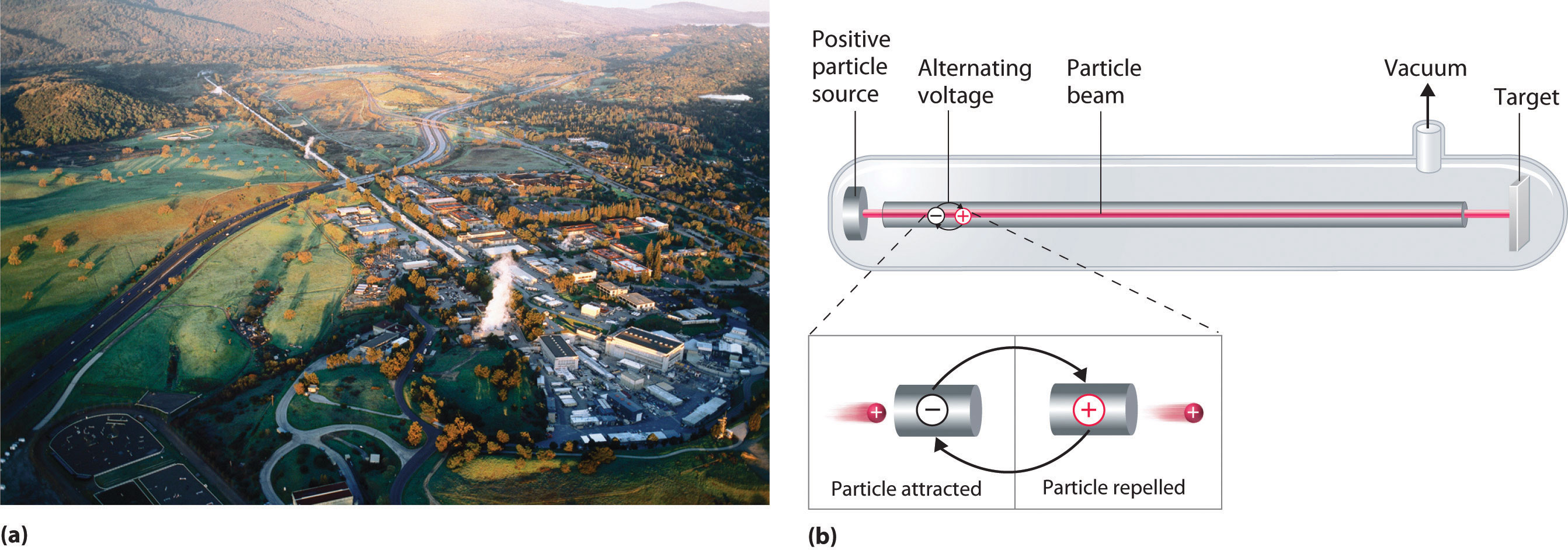6.7: Transmutation of the Elements
- Page ID
- 13196
Although the conversion of one element to another is the basis of natural radioactive decay, it is also possible to convert one element to another experimentally. The conversion of one element to another is the process of transmutation. In 1919 Rutherford converted a stable isotope to an unstable one. By bombarding \(\ce{^{14}N}\) with \(\alpha\) particles he created \(\ce{^{17}O}\), which is an unstable isotope of oxygen. Transmutation may also be accomplished by bombardment with neutrons.
\[\ce{^{14}_7N + ^4_2He \rightarrow ^{17}_8O + ^1_1H}\]
Historically, part of Alchemy was the study of methods of creating gold from base metals, such lead. Where the Alchemists failed in this quest, we can now succeed. Thus, bombardment of platinum-198 with a neutron creates an unstable isotope of platinum that undergoes beta decay to gold-199. Unfortunately, while we may succeed in making gold, the platinum we make it from is actually worth more than the gold making this particular transmutation economically non-viable!
\[\ce{^{198}_{78}Pt + ^1_0n \rightarrow ^{199}_{78}Pt \rightarrow ^{199}_{79}Au + ^0_{-1}\beta}\]
Transuranium Elements
Uranium (Z = 92) is the heaviest naturally occurring element. Consequently, all the elements with Z > 92, the transuranium elements, are artificial and have been prepared by bombarding suitable target nuclei with smaller particles. The first of the transuranium elements to be prepared was neptunium (Z = 93), which was synthesized in 1940 by bombarding a 238U target with neutrons. As shown in Equation \(\ref{20.41\) this reaction occurs in two steps. Initially, a neutron combines with a 238U nucleus to form 239U, which is unstable and undergoes beta decay to produce 239Np:
\[^{238}_{92}\textrm{U} + \, ^{1}_{0}\textrm{n} \rightarrow \,^{239}_{92}\textrm{U}\rightarrow \,^{239}_{93}\textrm{Np}+\,^{0}_{-1}\beta \label{25.4.1}\]
Subsequent beta decay of 239Np produces the second transuranium element, plutonium (Z = 94):
\[^{239}_{93}\textrm{Np} \rightarrow \,^{239}_{94}\textrm{Pu}+\,^{0}_{-1}\beta \label{25.4.2}\]
Bombarding the target with more massive nuclei creates elements that have atomic numbers significantly greater than that of the target nucleus (Table \(\PageIndex{1}\)). Such techniques have resulted in the creation of the superheavy elements 114 and 116, both of which lie in or near the “island of stability." As of this writing, 22 transuranium elements have been produced and officially recognized by IUPAC; several other elements have formation claims that are waiting for approval.
| Name | Symbol | Atomic Number | Reaction |
|---|---|---|---|
| americium | Am | 95 | \(\ce{^{239}_{94}Pu + ^1_0n ⟶ ^{240}_{95}Am + ^0_{−1}e}\) |
| curium | Cm | 96 | \(\ce{^{239}_{94}Pu + ^4_2He ⟶ ^{242}_{96}Cm + ^1_0n}\) |
| californium | Cf | 98 | \(\ce{^{242}_{96}Cm + ^4_2He⟶ ^{243}_{97}Bk + 2^1_0n}\) |
| einsteinium | Es | 99 | \(\ce{^{238}_{92}U + 15^1_0n⟶ ^{253}_{99}Es + 7^0_{−1}e}\) |
| mendelevium | Md | 101 | \(\ce{^{253}_{99}Es + ^4_2He ⟶ ^{256}_{101}Md + ^1_0n}\) |
| nobelium | No | 102 | \(\ce{^{246}_{96}Cm + ^{12}_6C ⟶ ^{254}_{102}No + 4 ^1_0n}\) |
| rutherfordium | Rf | 104 | \(\ce{^{249}_{98}Cf + ^{12}_6C⟶ ^{257}_{104}Rf + 4 ^1_0n}\) |
|
seaborgium
|
Sg
|
106
|
\(\ce{^{206}_{82}Pb + ^{54}_{24}Cr ⟶ ^{257}_{106}Sg + 3 ^1_0n}\) \(\ce{^{249}_{98}Cf + ^{18}_8O ⟶ ^{263}_{106}Sg + 4 ^1_0n}\) |
| meitnerium | Mt | 107 | \(\ce{^{209}_{83}Bi + ^{58}_{26}Fe ⟶ ^{266}_{109}Mt + ^1_0n}\) |
Particle Accelerators
A device called a particle accelerator is used to accelerate positively charged particles to the speeds needed to overcome the electrostatic repulsions between them and the target nuclei by using electrical and magnetic fields. Operationally, the simplest particle accelerator is the linear accelerator (Figure \(\PageIndex{2}\)), in which a beam of particles is injected at one end of a long evacuated tube. Rapid alternation of the polarity of the electrodes along the tube causes the particles to be alternately accelerated toward a region of opposite charge and repelled by a region with the same charge, resulting in a tremendous acceleration as the particle travels down the tube. A modern linear accelerator such as the Stanford Linear Accelerator (SLAC) at Stanford University is about 2 miles long.

To achieve the same outcome in less space, a particle accelerator called a cyclotron forces the charged particles to travel in a circular path rather than a linear one. The particles are injected into the center of a ring and accelerated by rapidly alternating the polarity of two large D-shaped electrodes above and below the ring, which accelerates the particles outward along a spiral path toward the target.
The length of a linear accelerator and the size of the D-shaped electrodes in a cyclotron severely limit the kinetic energy that particles can attain in these devices. These limitations can be overcome by using a synchrotron, a hybrid of the two designs. A synchrotron contains an evacuated tube similar to that of a linear accelerator, but the tube is circular and can be more than a mile in diameter. Charged particles are accelerated around the circle by a series of magnets whose polarities rapidly alternate.
Contributors and Attributions
Paul Flowers (University of North Carolina - Pembroke), Klaus Theopold (University of Delaware) and Richard Langley (Stephen F. Austin State University) with contributing authors. Textbook content produced by OpenStax College is licensed under a Creative Commons Attribution License 4.0 license. Download for free at http://cnx.org/contents/85abf193-2bd...a7ac8df6@9.110).
- Hans Lohninger (Epina eBook Team)
- Andrew R. Barron

